Is It Easy Yo Fake Hours at Deloitte
I used to work a lot — 60, 80, or even 100 hours a week.
I let my work be a big part of how I defined myself. I wore those insane hours like a badge of honor . . . I loved telling people how "busy" I was and how much I "had to do".
Sound familiar?
Looking back, I realize I used my work to try and fill a void in myself. The problem was that this void was like a black hole. No matter how many hours I worked, it never seemed to fill it up. If anything, it made me feel worse.
One day I'd had enough. Truth be told, I'd had way more than enough. I stopped and reevaluated my life, trying to figure out what was important to me, and what wasn't.
I had to make a big change. I had to figure out how to work smarter, not harder. I needed to optimize my work process to do more in less time.
I needed the Pomodoro Technique. Here's how this incredible simple time management system changed my workday—and ultimately, my life. I think it can do the same for you.
What Is The Pomodoro?
Over the years I'd heard about a time management system called the Pomodoro Technique. It seemed too simple, but as they say, the simplest things often work best.
I read the 2006 paper written by its creator, Francesco Cirilio, which explained the technique and as importantly, the psychology behind it. This revolutionary time management system is deceptively simple to learn, but life changing when applied correctly. The Pomodoro Technique can be broken down into the following four basic principles.
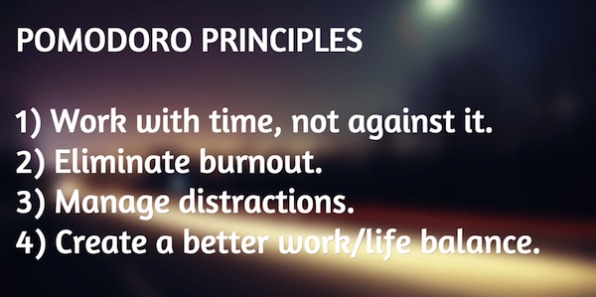
1. Work with time, not against it: Many of us live as if time is our enemy. We race the clock to finish assignments and meet deadlines. The Pomodoro Technique teaches us to work with time, instead of struggling against it.
2. Eliminate burnout: Taking short, scheduled breaks while working eliminates the "running on fumes" feeling you get when you push yourself too hard. It's impossible to overwork when you stick to the system.
3. Manage distractions: Phone calls, emails, Facebook messages, or suddenly realizing you need to change the oil in your car — distractions constantly bombard us. Usually, these distractions can wait. The Pomodoro Technique helps you log your distractions and prioritize them for later.
4. Create a better work-life balance: Most of us are far too intimately acquainted with the guilt that comes from procrastination. If we haven't had a productive day, we can't seem to enjoy our free time. As a Pomodoro master, you create an effective timetable and achieve your high-priority tasks, so you truly enjoy your time off.
The Pomodoro Process: 25 Minutes Of Focus
Right now you're probably thinking: "This all sounds great, but what the heck do I actually do?"
It's actually quite simple:
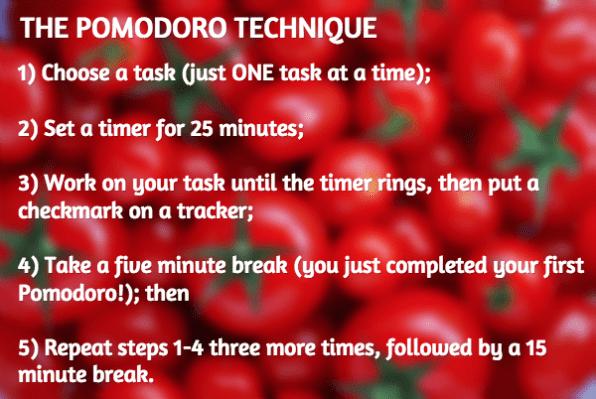
Right now, you're probably thinking, "Twenty-five minutes of work? That's nothing! This is gonna be easy!"
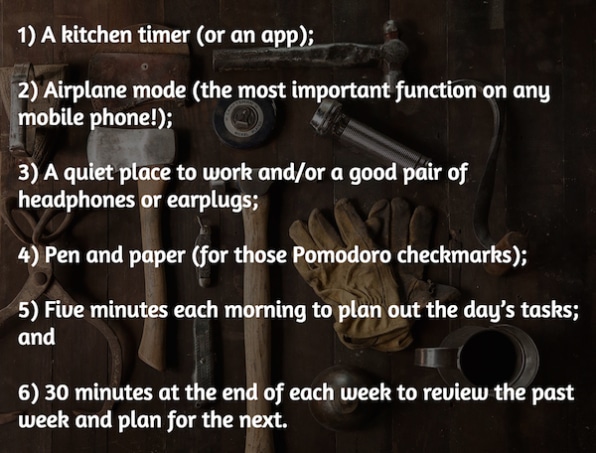
My First Tries With Pomodoro: "Ugh"
Like most things in my life, I learned through experimentation, experiencing a lot of pain and frustration but ultimately growth.
At first, I thought I could do 16 Pomodoros each day . . . no problem. I was used to working so much that less than seven hours of work seemed like a breeze!
The first day I completed 12 Pomodoros. I got a ton done, but still felt like a failure because I fell short of my goal. I felt tired . . . and miserable.
Ugh.
Over the following days, I tried to cut back on my target number. When it worked, I got a ton of stuff done and felt amazingly productive. I knew I was onto something good. Other days, I did too little or too much and I felt like crap . . . and I was convinced this was the dumbest system in the world.
Double ugh.
One day, I just ignored the system altogether and went back to multitasking. I was unfocused, unproductive, and frustrated. I gritted my teeth and kept doing things my old way for a few more days. What I found was that I got things done, but my productivity simply couldn't compare to when it all clicked with the Pomodoros.
Triple ugh.
Finding My Balance: The Magic Of 8
Eventually my sanity returned. I began to experiment with smaller numbers of Pomodoros, starting with five per day and gradually working my way up to eight. My goal was eight Pomodoros each weekday, for a total of 40 per week.
This worked (sort of), but as they say, life happens. Some days I had so many meetings to attend, or my daughter had a recital at school that I didn't want to miss, and I just couldn't find the time to fit in eight Pomodoros.
It was clear to me that 40 was my magic weekly number . . . but I needed to be less rigid with how I approached my workweek.
The math was straightforward:
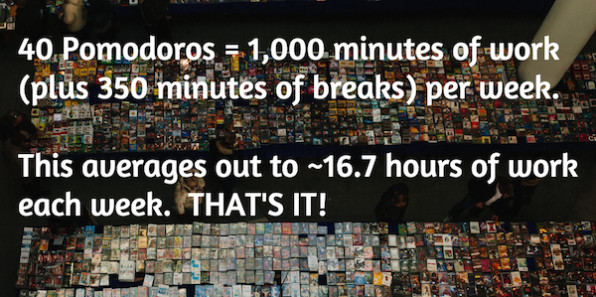
However, when I had too much going on, or felt physically or mentally off, I couldn't fit in eight Pomodoros. I'd fall behind, and next day I'd try to cram in 14, leaving me exhausted and not very happy with the quality of my work.
I realized I had to step back and rethink my week, paying attention to my moods. To refocus on what was right for me. The Pomodoro Technique was great, but something was missing to make it really work for me.
How I Learned To Love The Seven-Day Workweek (Really!)
When I decided to change, I swore to myself I'd never work on weekends, holidays, vacations, or even after 5 p.m. Great, right? Well, I'm happy to report I've broken all of these promises, and that's actually a good thing.
On those days when I couldn't finish eight Pomodoros by 5 p.m., I'd feel stressed. I'd feel like a failure. Suddenly I realized my view of the workweek was too limiting. Why did I make those commitments to myself, limiting when I could work? I did it because I was coming from an unfulfilling work life, working too many hours, and for the wrong reasons.
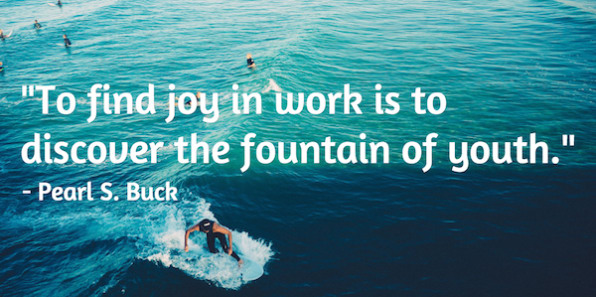
I transitioned from just working to working on things that fulfilled me. What's more, I gave myself the freedom to do non-work stuff, such as attending my daughter's recital during what most people consider work hours. This made it easy to shift my mind-set about when I could or couldn't work.
The final piece to my puzzle was moving from a five-day workweek, where I had to stop by 5 p.m., to a seven-day workweek, where I could work when it suited me. This took me from 40–45 hours available to get my 40 Pomodoros in, to having 168 hours each week. Since I only need 16.7 hours net, that means I only work 10% of my time. What a difference!
Everything In Just 16.7 Hours A Week?!
Right now you're probably thinking, "I work more than that in two days! And you're trying to tell me that's all I need to work in an entire week?"
Yes! That's exactly what I'm telling you. And no, you'll probably still "work" more than 16.7 hours a week. Let me explain.
I "work" 35–40 hours a week, but I spend at least 20–25 of those hours on calls, meetings, networking on- and offline, and other less-focused tasks. These are important, but I don't count them as "work" time.
I truly work 16.7 hours each week . . . and I get about five times more accomplished in those few hours than in the other 25 hours.
There's no avoiding it. Life happens. As long as humans are involved, and especially if you live in modern society with its 24/7 connectedness, it's next to impossible to have a perfect working environment. However, you can work smarter without having to work harder.
The Psychology Of Motivation: Mastering Your Energy
In a perfect world, I'd have eight high-value tasks identified at the start of each workday. I'd prioritize these, and knock them off one by one, from most important to least. I'd be equally enthusiastic and motivated about each one, wouldn't be interrupted, and would finish my day's work in less than three hours.
Sounds great, right? Unfortunately, "we live nowhere near perfect."
The reality is that I'm a human being, living in a world full of other humans. I have emotions I don't control, and I often get tired. Some tasks I simply don't feel like doing, even though I know they're important—possibly even urgent.
To make this work long-term, I had to face these things and learn to work with, rather than against them.
My energy level and attitude affect my work and output, so I had to stay present to how I was feeling, and master myself. This post on mastering one's energy made it all click. I found these questions especially helpful:
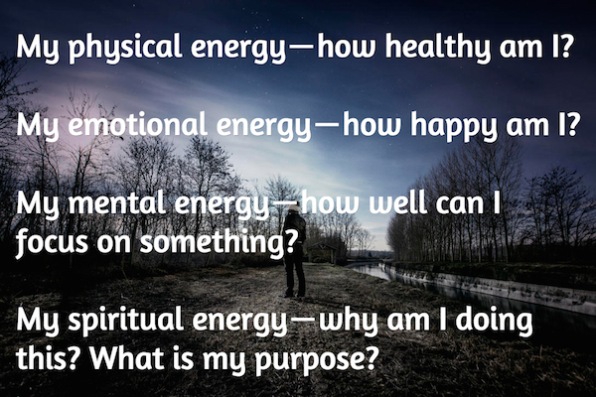
These questions helped me take into account my mood and energy when prioritizing tasks. As a result, I no longer do anything just because I feel I have to.
When my physical energy is low, I work on my health and wellness. When my emotional energy is low, I find something that makes me happy, like spending time with my wife and daughter.
Of course, I also had to find work I enjoyed, that fulfilled me . . . rather than work that drained me. By doing this, I have more time to improve myself, be with friends and family, and truly be healthy on all levels — mind, body, and soul.
Want To Go Further?
Slowly but surely, Pomodoro has forever changed how I work . . .
Are you up for it?
Action idea: Why not try one Pomodoro today? Twenty-five minutes of concentrated work on one task. Start with one and work up from there.
And if you want to go further, I want to make it as easy as possible for you.
Click here to get access to my free 32-page guide that explains my simple system in detail and includes worksheets, tools, and resources that you can print out and use. Save 23.3 hours each week and get more accomplished!
This article originally appeared on Buffer and is reprinted with permission.
Related: Productivity Tips from the Busiest People
Source: https://www.fastcompany.com/3053036/the-simple-technique-to-fit-a-40-hour-work-week-into-167-h
0 Response to "Is It Easy Yo Fake Hours at Deloitte"
Enviar um comentário